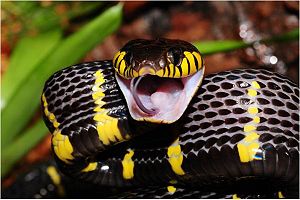Sandbox Reserved 932
From Proteopedia
(Difference between revisions)
| Line 16: | Line 16: | ||
[[Image:Mangrove snake.jpg|300px|right|thumb| Mangrove catsnake]] | [[Image:Mangrove snake.jpg|300px|right|thumb| Mangrove catsnake]] | ||
| - | [[Image:Kolme_sormea_figure_text.png|300px|right|thumb| Three fingers formed by three peptide loops (F1, F2 & F3)]] | + | [[Image:Kolme_sormea_figure_text.png|300px|right|thumb| Three fingers formed by three peptide loops (F1, F2 & F3) [PDB=2H5F]]] |
Denmotoxin is a snake venom protein produced by ''Boiga dendrophila'' ([http://en.wikipedia.org/wiki/Boiga_dendrophila mangrove catsnake]) which belongs to a family of well studied three-fingered neurotoxins. | Denmotoxin is a snake venom protein produced by ''Boiga dendrophila'' ([http://en.wikipedia.org/wiki/Boiga_dendrophila mangrove catsnake]) which belongs to a family of well studied three-fingered neurotoxins. | ||
Revision as of 09:43, 15 May 2014
| This Sandbox is Reserved from 01/04/2014, through 30/06/2014 for use in the course "510042. Protein structure, function and folding" taught by Prof Adrian Goldman, Tommi Kajander, Taru Meri, Konstantin Kogan and Juho Kellosalo at the University of Helsinki. This reservation includes Sandbox Reserved 923 through Sandbox Reserved 947. |
To get started:
More help: Help:Editing |
B. Dendrophila monomeric toxin (Denmotoxin) is the primary protein of snake venom used by Boiga dendrophila. This colubrid snake lives in Southest Asian lowland rainforest and mangrove swamps using birds as its primary prey.
One of the most well characterized snake venom protein families is the Three-finger-toxins (3FTX). These proteins have three β-stranded finger-like loops, stabilized by four disulphide bridges on the surface of a globular core. In non-convential 3TFXs a fifth disulphide bridge can be present as is the case in Denmotoxin.
How the overall structure looks like? Subunits orientation, chains: the number and relative positions, etc.
Denmotoxin
| |||||||||||

![Three fingers formed by three peptide loops (F1, F2 & F3) [PDB=2H5F]](/wiki/images/thumb/3/3f/Kolme_sormea_figure_text.png/300px-Kolme_sormea_figure_text.png)
